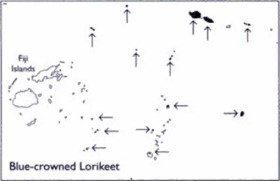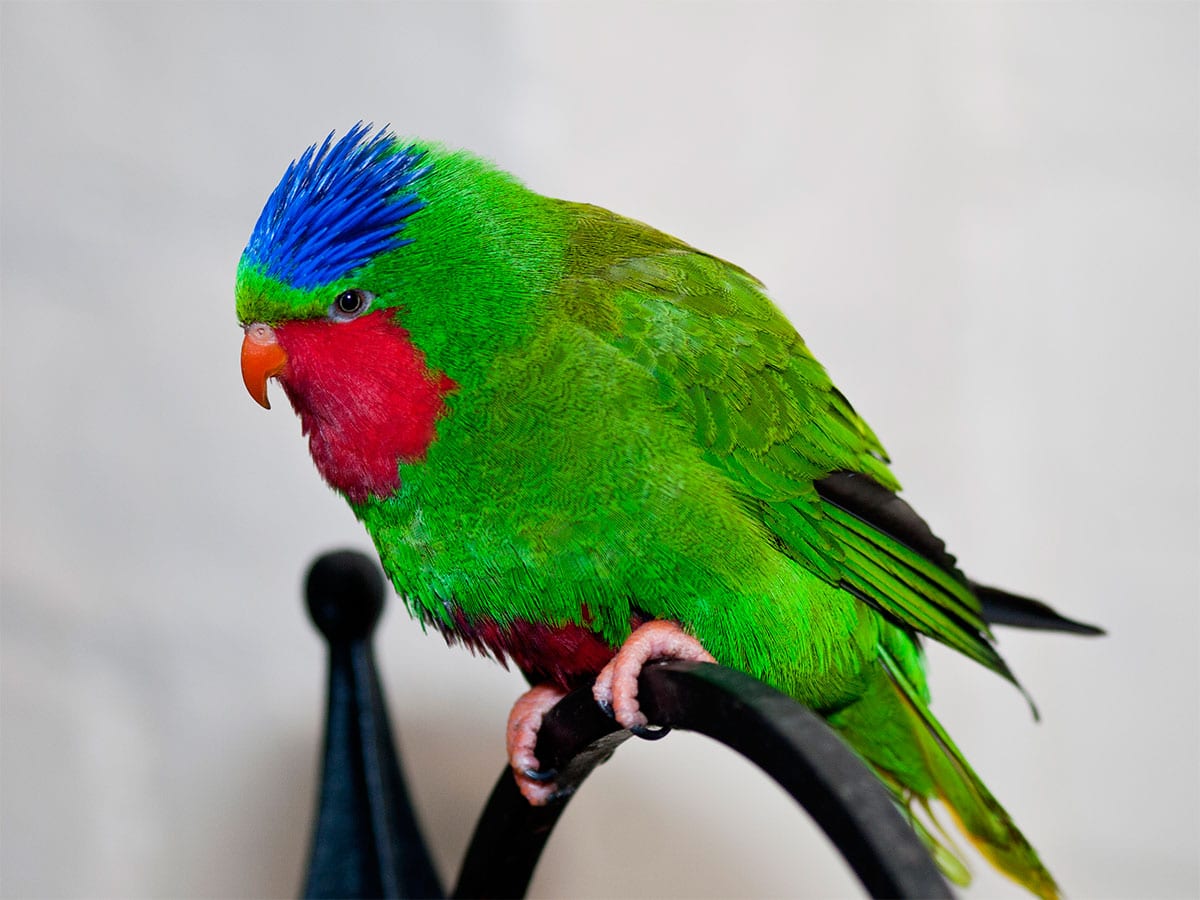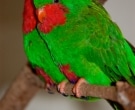Content |
|---|
Description
19 cm.. of length and a weight of 40 to 55 g..
The Blue-crowned Lorikeet (Vini australis) has a plumage mostly green. The upper part of the head is dark blue with light blue streaks. The region of the windows of the nose, the cheeks, the ear-coverts, the neck and the abdomen They are red. the lower part of abdomen and the thighs they are purple blue. The back is green, the interior of the tail is yellowish-green. The irises is reddish brown. The legs are of color red and the bill is orange.
The youth are equal to adults, but with less red in the face and throat, little or none abdominal patch, stripes blue shorter in the crown, no purpura on the thighs, brown the eyes.
- Sound of the Blue-crowned Lorikeet.
Habitat:
It is found in forests, coconut palms or any habitat where flowering trees; coastal mountains, gardens and agricultural areas. Nomad, sometimes traveling between the Islands.
Daily movements in search of food. Aggressive but gregarious, they often move in flocks of up to 12 individuals, except during the breeding season they live with their partners.
In Samoa it is common around villages and plantations and less common in moist forests, higher elevations in the rain forest and secondary growth.
Reproduction:
Nests in holes or hollows of trees, It has also been reported that they dig burrows in the banks of Earth, Although it has not confirmed. The laying is one or two white eggs. Breeding registered in June and August. In captivity the incubation It has been calculated in 23 days.
Food:
It feeds on nectar, pollen and red fruits. It particularly prefers Erythrina, Wild hibiscus and coconut.
Distribution:

Extends over the archipelagos of Samoa, Tonga and LAU, distributed by Islands: Love, Futuha'a, Fulago, Futuna, Ha'afeva, You're young, Moce, Niue, Ofu, Olosega, Samoa, Salt, Tafahi, Say, Tofua, Tungua, Fire, It's cool, Varoa, I'm sorry and Voleva. In the past was also in ‘USA, Tongatapu and Mata-Utu but there it is extinct.
Conservation:
– Current IUCN Red List category: Least concern.
– The population trend: Decreasing.
The world population It has not been quantified, but the species is informed that it is common in much of its restricted area of distribution.
The population is suspected to be in decline due to the predation by species invasive.
Still fairly common throughout its range, but it has become extinct on many islands and it is decreasing in Tonga (probably because of the rats).
"Blue-crowned Lorikeet" in captivity:
Like the others Vini lories, the Blue-crowned Lorikeet still quite rare in poultry farming, probably as a result of the protection they receive in their native South Pacific countries.
Alternative names:
– Blue-crowned Lorikeet, Blue crowned Lorikeet, Blue-crowned Lory (ingles).
– Lori fringillaire (French).
– Blaukäppchen (German).
– Loris Vini Australis (Portuguese).
– Lori de Samoa (español).
scientific classification:
– Order: Psittaciformes
– Family: Psittaculidae
– Genus: Vini
– Scientific name: Vini australis
– Citation: (Gmelin, 1788)
– Protonimo: Psittacus australis
Images “Blue-crowned Lorikeet”:
Videos "Blue-crowned Lorikeet"
————————————————————————————————
“Blue-crowned Lorikeet” (Vini australis)
Sources:
– Avibase
– Parrots of the World – Forshaw Joseph M
– Parrots A Guide to the Parrots of the World – Tony Juniper & Mike Parr
– BirdLife.org
– Photos:
1 – “Vini australis-London Zoo, England-8a” by William Warby from London, England – Unknown-Tropical BirdUploaded by Snowmanradio. Licensed under CC BY 2.0 via Wikimedia Commons.
2 – “Vini australis-two on a perch-8a-4c” by Vini_australis_-two_on_a_perch-8a.jpg: TJ Lin – originally posted to Flickr as Dscn6140 and uploaded to commons at Vini_australis_-two_on_a_perch-8a.jpg. Licensed under CC BY-SA 2.0 via Wikimedia Commons.
3 – By Duncan Wright (Own work) [GFDL or CC BY-SA 3.0], via Wikimedia Commons
4 – By Steven G. Johnson on commons (same as unnormalized on flickr) (Dsc_0014uploaded by Snowmanradio) [CC BY-SA 2.0], via Wikimedia Commons
5- by Zambar – zoochat.com
– Sounds: Samuel Jones (Xeno-canto)






